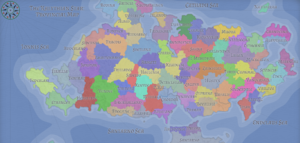Order of the Kalythian Star
Order of the Kalythian Star | |
|---|---|
|
Flag | |
| Motto: In Altissimis Infernis Stamus Custodiam (Latin) | |
| Anthem: "Marcha Kalicia" (Spanish) | |
| Capital | Pax Kalythia |
| Largest city | The Yaan |
| Official languages | |
| Ethnic groups |
|
| Demonym(s) | Kalythian |
| Government | Semi-Republic |
| Connorson Angely | |
| Legislature | Councils of the Ministerial Government |
| Establishment | |
| 7 February 1790 | |
| Area | |
• Total | 43,593,052 km2 (16,831,371 sq mi) |
• Water (%) | 6.6 |
| Population | |
• June 2024 estimate | 6,350,000,000 |
• Density | 145.7/km2 (377.4/sq mi) |
| GDP (PPP) | 2023 estimate |
• Total | $1.421 trillion |
• Per capita | $71,344 |
| GDP (nominal) | 2023 estimate |
• Total | $955.3 billion |
• Per capita | $67,231 |
| Gini (2020) | 29.7 low |
| HDI (2023) | very high |
| Currency | Kalythian Kalyn (KLN) |
| Time zone | KST |
• Summer (DST) | not observed |
| Driving side | right |
| Calling code | +279 |
| Internet TLD | .ks |
The Order of the Kalythian Star, commonly known as Kalythia, is a country primarily located on the Kalythian continent. It is a unitary state composed of 75 total provinces along with the capital district of Pax Kalythia. Kalythia shares no land borders with any other state and is surrounded by four major bodies of water on all sides, with the Jonnis Sea to the west and northwest, Santarno Sea to the southwest, Endelaus Sea to the east and southeast, and Cathadh Sea to the north and northeast. Kalythia possesses no overseas territories but claims sovereignty over much of the surrounding bodies of water. The country is one of the largest in the world in terms of both population and geographical size, with a population of over 6 billion and a land area of about 43.5 million square kilometers (16.8 million square miles).
The Kalythian continent has remained uninhabited for much of human history. The first human settlements were constructed from 1790 onwards by French refugees, primarily those of the upper classes, fleeing from the French Revolution. Initially founded as a confederation under a theocratic government, discontent over the standard of living, state of the economy, and nature of the justice system sparked the People's Revolution which lasted from 1810 to 1822. Following the conflict, the government then transitioned to a representative democracy and expanded across the continent. The country received several large influxes of refugees for the rest of the 19th century from elsewhere in the world, mostly due to the outbreak of conflict in various regions. In the mid- and late-1800s, Kalythia experienced extensive immigration from Latin America during the Spanish American wars of independence, and from North Africa and Southwest Asia during the European wars of colonization there. By 1880, Kalythia established itself as one of the world's leading industrial powers, Proliferation of conflict throughout the rest of the world during the first half of the 20th century compelled the country to adopt a militaristic foreign policy towards nearby nations. sparking a series of intense wars that would leave Kalythia in a near-permanent state of continuous conflict for the rest of the century. Public disproval of the democratic government due to the ensuing privations caused by the wars resulted in the 1997 takeover by the nationalist Treville United Coalition political party, which returned the country to a state of isolationism that continues to the present day.
The Kalythian national government is a unitary semi-republic and ministerial democracy with no distinct branches of government. It possesses a bicameral legislature consisting of the Lower Council and the Upper Council, with the latter wielding more political power than the former. Placement of each ministy in a council along with its general influence on policymaking depends greatly on the overall national government's issues and priorities at any given time. The national government is headed by the Supreme Minister, which exerts absolute power over all other government bodies and serves for life, but must be voted into office by both the Lower and Upper Councils. The country's political culture promotes peace, economic success, rationality, natural rights, and a balance between order and liberty.
As one of the world's most developed countries, Kalythia possesses one of the largest economies and GDPs in the world. It boasts a minimal gap in income inquality along with ranking high among the world in numerous metrics including economic performance, innovation, and education. Kalythia, following its isolationist foreign policy, is not a member of the World Assembly nor many prominent international organizations, and harbors very few diplomatic ties with other countries. Neverthless, it pursues economic and financial cooperation with most other nations and practices free trade.

